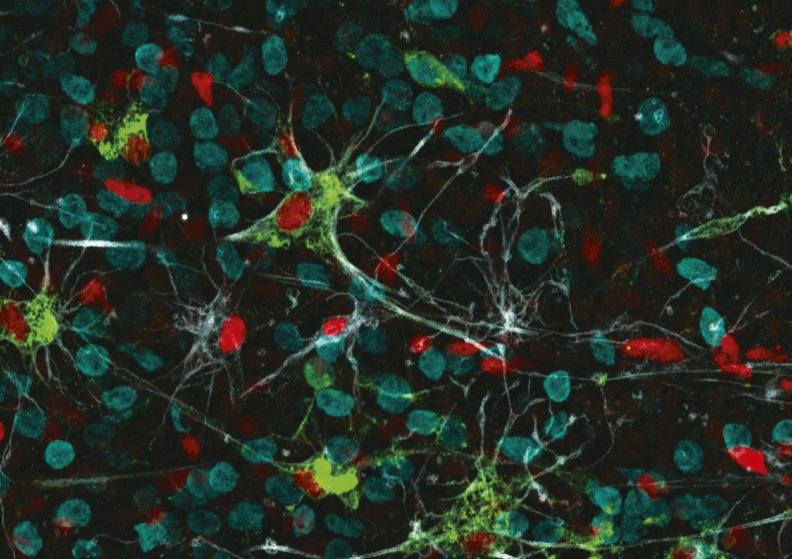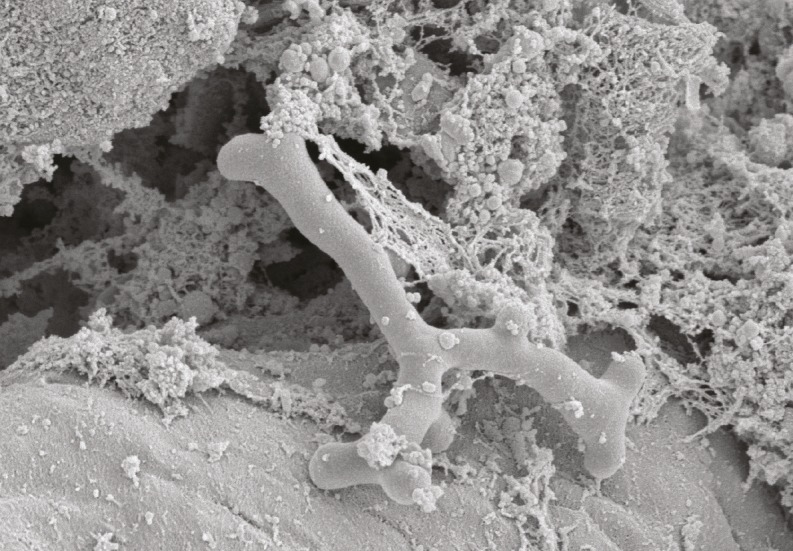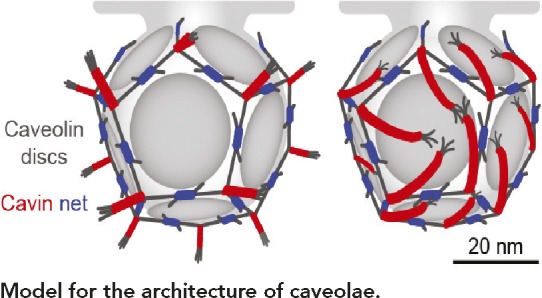How Zika virus attacks the developing human brain

Developing human brain with ZIKV (green) reveals preference for astrocytes (red/grey) and limited infection of neurons (cyan).
Congenital Zika virus (ZIKV) infection has been tied to birth defects, such as microcephaly, but the virus’ mechanism of action and precise target cells in the fetal brain remain unclear. Using primary human brain cortical tissue cultures, Hanna Retallack et al. (pp. 14408–14413) found that in the second-trimester fetal brain ZIKV targets neural stem cells, astrocytes, oligodendrocyte progenitors, and microglia, while largely sparing neurons. Infection of astrocytes late in fetal brain development might explain the clinical reports of calcified bands observed in the brain’s cortical plate among newborn children with congenital ZIKV infection. Blocking a putative viral entry factor called the AXL receptor using antibodies and CRISPR interference suggested that the extracellular domain of the receptor, which likely serves as a viral handhold, is critical for glial cell infection. Further, the authors screened more than 2,100 FDA-approved chemical compounds, including drugs considered safe for use during pregnancy, and found that the macrolide antibiotic azithromycin (AZT), currently prescribed for treating sexually transmitted infections in pregnant women, reduced viral replication and virus-induced damage in cultured human glial cells. AZT outperformed daptomycin, known for its anti-ZIKV activity in cultured cells, in lowering the infection rate of cultured glial cells. According to the authors, the findings offer a fulcrum for the development of therapeutic strategies against congenital ZIKV infection. — P.N.
Expanding applications of noninvasive prenatal testing
Noninvasive prenatal testing (NIPT) has been widely used to detect fetal chromosomal abnormalities by analyzing cell-free fetal DNA present in maternal plasma. K. C. Allen Chan et al. (pp. E8159–E8168) used high-resolution genome-wide sequencing of fetal DNA in maternal plasma to expand the potential applications of NIPT. The authors used ultradeep sequencing and bioinformatics filters to detect de novo mutations in fetal DNA across the genome and with higher sensitivity and predictive value than previous attempts. The authors validated the approach by using noninvasive maternal plasma DNA analysis on a second trimester pregnancy, and successfully detected a de novo mutation responsible for a fetal genetic disorder. Next, the authors used the technique to determine the maternal inheritance of fetal single-nucleotide polymorphisms across the genome with a 90-fold increase in resolution, compared with previous methods. The authors also observed that certain genomic locations were more likely to be found at the ends of plasma DNA fragments, with some locations preferentially associated with either fetal or maternal DNA. The authors suggest that these sites could be used to estimate the fetal DNA fraction in a particular sample. Advances in sequencing and bioinformatics could thus expand the applications of NIPT, according to the authors. — S.R.
Symbiotic bacteria induce immune cells in mammalian gut

Scanning electron micrograph of B. adolescentis on the ileal surface.
The mammalian gut harbors a complex ecosystem of symbiotic bacteria that constitute a core component of host physiology. For example, Segmented Filamentous Bacteria (SFB) in mice induce Th17 cells to accumulate in the intestines, where the cells fortify intestinal barriers and ward off microbial challenges. Seeking a functional analog for SFB in humans, Tze Guan Tan et al. (pp. E8141–E8150) screened a large set of candidate microbes derived from the human gut and identified Bifidobacterium adolescentis, a symbiont that can increase Th17 cells in the murine gut. Although enrichments of Th17 cells by SFB and B. adolescentis produce similar effects on the host’s small intestinal immune system, the authors reveal that B. adolescentis elicits a distinct gene expression program, suggesting a potentially different mechanism for inducing Th17 cells. In a series of trials, the authors also demonstrate that B. adolescentis promotes autoimmune inflammation in a mouse model of arthritis. The findings support claims that common probiotic formulations including bifidobacteria might help support immune function. However, boosting Th17 populations may also promote chronic inflammatory diseases, such as rheumatoid arthritis and multiple sclerosis, according to the authors. — T.J.
Gene associated with alcohol consumption
Alcohol drinking is a complex, heritable trait, but few genes are known to be associated with it. To identify genes associated with nonaddictive alcohol consumption, Gunter Schumann et al. (pp. 14372–14377) performed a genome-wide association and replication study analyzing alcohol intake in more than 105,000 individuals of European descent. The authors identified a variant of the gene encoding β-Klotho—an essential coreceptor for the hormones FGF21 and FGF19—that was associated with alcohol consumption. FGF21 has been previously associated with macronutrient preference in humans and suppression of alcohol and sweet preference in mice. The authors found that mice lacking β-Klotho in the brain showed significantly increased alcohol preference and consumption, compared with mice with β-Klotho. Pharmacologic administration of FGF21 failed to inhibit alcohol preference in mice lacking β-Klotho, suggesting that the effects of FGF21 on alcohol consumption depend on β-Klotho expression in the brain. The authors also found that mice lacking β-Klotho did not show any difference in measures of anxiety, compared with mice with β-Klotho. The results suggest that a pathway operating between the liver and brain and involving FGF21 and β-Klotho plays a role in regulating alcohol drinking in humans, and could serve as a potential pharmacologic target for reducing alcohol consumption, according to the authors. — S.R.
Polyhedral architecture of caveolae

Model for the architecture of caveolae.
Mammalian plasma membranes often contain protein-coated invaginations called caveolae that are important for functions, such as signaling and vesicular trafficking. The caveolar protein coat is made up of membrane-associated proteins called caveolins and peripherally attached proteins called cavins, but the structure of caveolae remains unclear. Miriam Stoeber et al. (pp. E8069–E8078) used structural analysis of cavin and caveolin complexes and cryoEM and tomography of caveolae in situ to examine the structure of caveolae. Oligomers of the purified cavin protein Cavin1 made a filamentous protein mesh capable of forming a polyhedral lattice around vesicles. The authors also found that two Cavin1 coiled-coil domains were required for Cavin1 complex formation. Cryoelectron tomography of caveolae inside cells revealed polygonal membrane profiles, and the authors suggest that the caveolar coat has an underlying polyhedral architecture. The authors also found that purified caveolin formed homogeneous disc-like oligomers. Based on the sizes and stoichiometries of the cavin and caveolin proteins involved, the authors propose a model for caveolae architecture consisting of a regular dodecahedron that forms the underlying structure of flexible net-like cavin filaments, with caveolin discs occupying the dodecahedron’s faces. — S.R.


